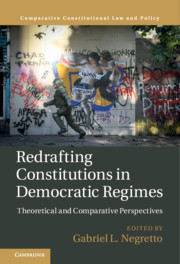Book contents
- Redrafting Constitutions in Democratic Regimes
- Comparative Constitutional Law and Policy
- Redrafting Constitutions in Democratic Regimes
- Copyright page
- Dedication
- Contents
- Tables
- Contributors
- Acknowledgments
- 1 New Constitutions in Democratic Regimes
- Part I Conceptual, Normative, and Empirical Issues
- Part II Case Studies
- 6 The Difference Power Diffusion Makes
- 7 Democratic Constitutional Replacements and Majoritarian Politics
- 8 Thailand’s Democratic Moment
- 9 Political Elites and the People
- 10 The Anatomy of Constitution Making
- Index
- References
9 - Political Elites and the People
Kenya’s Decade-Long Constitution-Making Process
from Part II - Case Studies
Published online by Cambridge University Press: 29 August 2020
- Redrafting Constitutions in Democratic Regimes
- Comparative Constitutional Law and Policy
- Redrafting Constitutions in Democratic Regimes
- Copyright page
- Dedication
- Contents
- Tables
- Contributors
- Acknowledgments
- 1 New Constitutions in Democratic Regimes
- Part I Conceptual, Normative, and Empirical Issues
- Part II Case Studies
- 6 The Difference Power Diffusion Makes
- 7 Democratic Constitutional Replacements and Majoritarian Politics
- 8 Thailand’s Democratic Moment
- 9 Political Elites and the People
- 10 The Anatomy of Constitution Making
- Index
- References
Summary
Kenya adopted a new constitution in 2010 after a long and difficult journey. It was the result of two processes, involving different bodies, different decision-making rules, and each under significantly different political conditions. This chapter describes these linked processes, exploring why the first failed and the second led to the adoption of a new constitution. There is, of course, no simple or single answer to this question but, as the chapter shows, a central difference between them was the different ways in which they dealt with elites and ordinary citizens. In short, insisting on a "people-driven" process and failing to secure elite buy-in was fatal for the first process; requiring consensus among the elite, along with a degree of public involvement, was key to bringing the second process to a successful conclusion.
Keywords
- Type
- Chapter
- Information
- Redrafting Constitutions in Democratic RegimesTheoretical and Comparative Perspectives, pp. 190 - 216Publisher: Cambridge University PressPrint publication year: 2020
References
References
Official Documents and Laws
- 3
- Cited by

